Tercio
A tercio (Spanish pronunciation: [ˈteɾθjo] "third") or tercio español ("Spanish third") was a type of Spanish pike and shot infantry unit known for its numerous victories on the battlefields of Europe during the 16th century and the first half of the 17th century, and was a major development of early modern combined arms warfare.
.jpg)
The tercio was an administrative unit nominally composed of up to 3,000 soldiers (but in practice usually 1,000 to 2,000 due to illness, desertion or manpower shortages) subdivided originally into 10 (later 12) compañías, composed of pikemen and arquebusiers or musketeers. These companies were deployed in battle and were further subdivided into units of 30 soldiers. These smaller units could be deployed individually or brought together to form what were sometimes called "Spanish squares." Tercio-type units were also used by other European powers, especially the Imperial Army of the Holy Roman Empire.
The care that was taken to maintain a high number of viejos soldados ("old soldiers" or veterans) in the units, and their professional training, together with the particular personality imprinted on them by the hidalgos of the lower nobility that commanded them, made the tercios the best infantry in Europe for over a century.[1]
History

The use of massed pike formations by Spanish armies began in the Granada War (1482–92). During the Italian Wars (1494-1559), the Spanish general Gonzalo Fernández de Córdoba, called "El Gran Capitán" ("The Great Captain") combined pikemen, arquebusiers and swordsmen (rodeleros) into colunelas ("columns") as a counter to the French army of the Valois kings, composed of heavily armoured gendarmes (professional versions of the medieval knight), Swiss and German Landsknecht mercenary pikemen, and heavy cannons. These conflicts at the end of the 15th century and during the early 16th century evolved into a tactically unique combination of combined arms centered around heavy infantry.[2].
A colunela, later called coronelía ("colonelcy"), commanded by a coronel ("colonel"), appointed by the King, would theoretically have up to 6,000 men, but by 1534 this had been reduced to the tercio with a nominal maximum of 3,000.[3]
Armies using tercio companies of 250 to 300 soldiers generally intended to field four of these companies in a tercio, with three tercios arrayed with one in front and two behind, in echelon formation on either side. The Spanish tercios rarely had more than 1500 men in practice, originally consisting of 1/3 pikemen, 1/3 swordsmen, and 1/3 arquebusiers or musketeers. Over time, the number of swordsmen was gradually reduced, and the composition of the tercio became 1/2 pikemen and 1/2 musketeers. The only tercio to have its full complement of 3,000 men was the Tercio de Galeras or the "Galleys' Tercio", dedicated only for deployment in galleys and galleons and specialized in naval warfare and amphibious warfare. It was assigned in 1537 by royal assent to the Spanish fleets in the Mediterranean and is the ancestor of the modern Spanish Marine Infantry.
Composition and characteristics
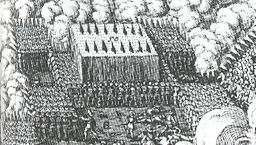
Although other powers adopted the tercio formation, their armies fell short of the fearsome reputation of the Spanish, who possessed a core of professional soldiers, which gave them an edge that was hard for other states to match.[4] That army was further supplemented by "an army of different nations", a reference to the fact that many of the troops were from the German states, and the Italian and Walloon territories of the Spanish Netherlands, as was characteristic of European warfare before the levies of the Napoleonic Wars. In the 16th and 17th centuries, however, the core of Spanish armies were formed by Spanish subjects, who were frequently praised by others for their cohesiveness, superiority in discipline and overall professionalism.[5]
Formations
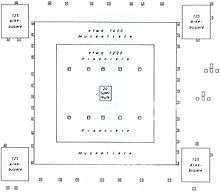
Within the tercio, ranks of pikemen arrayed themselves together into a hollow pike square (cuadro) with swordsmen – typically equipped with a short sword, a buckler, and javelins – inside; as the firearm rose in prominence, the swordsmen declined and were phased out. The arquebusiers (later, musketeers) were usually split up in several mobile groups called "sleeves" (mangas) and typically deployed with one manga at each corner of the cuadro. By virtue of this combined-arms approach, the formation simultaneously enjoyed the staying power of its pike-armed infantry, the ranged firepower of its arquebusiers, as well as the ability to conduct assaults with sword-and-buckler men. In addition to its inherent ability to repulse cavalry and other units along its front, the long-range firepower of its arquebusiers could also be easily shifted to the flanks, making it versatile in both offensive and defensive evolutions, as demonstrated by the success of the tercios at the Battle of Pavia in 1525.
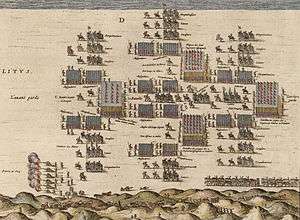
Groups of tercios were typically arrayed in dragon-toothed formation (staggered, with the leading edge of one unit level with the trailing edge of the preceding unit; see the similar hedgehog defence concept). This enabled enfilade lines of fire and somewhat defiladed the army units themselves. Odd units alternated with even units, respectively one forward and one back, providing gaps for an unwary enemy to enter and outflank itself, where it would become subjected to the combined direct and raking crossfire from the guns of three separate tercios. From their inception, tercio formations were meant to co-ordinate their field operations with cavalry.
Leadership of the Tercio

Mirroring military organization today, the tercio was led by a Maestre de Campo appointed by the King as the commanding officer and guarded by eight halberdiers. Assisting him was the sergeant major and a Furir Major in charge of logistics and armaments, with companies led by a Captain, also of royal appointment, with an Ensign in charge of the company color.
Companies had Sergeants, Furrieles (Furirs) and Corporals in them. The Sergeants served as seconds-in-command of the company and brought the captain's orders to his soldiers; the Furrieles were at orders to provide the necessary weapons and munitions, as well as additional men to the companies; and the Corporals, who led groups of 25 (similar to today's platoons), were always in obedience to the Captain's orders and brought to him any possible cases of disorder in the unit.
Each company had corps of drums made up of drummers and fifers, sounding duty calls in battle, with the drum major and fife major being provided by the tercio headquarters.
The tercio staff included a medical component (made up of a professional medic, a barber, and surgeons), chaplains and preachers, and a judicial unit, plus military constables enforcing order. They all reported to the Maestre de campo directly.
Organization
Tercios that initially served in Italy and the Spanish Netherlands were organized into:
- 10 companies of 300 led by Captains, in which
- 8 were Pikemen's Companies and
- 2 were of arquebusiers
The companies were later reduced to 250-strong units.
During the actions in the Netherlands, the tercios were reorganized into three coronelias ("colonelcies"), led by coronels ("colonels") each composed of a headquarters unit and four companies each (the predecessor of today's battalions), but as a whole continued to be subdivided into the same 12 companies of 250 personnel each, two of arquebusiers and 10 of pikemen. Colonels were also of royal appointment.
Staff


- Maestre de Campo - colonel
- Coronel - colonel/lieutenant colonel
- Sargento mayor - major
- Furriel mayor - quartermaster
- Capellán mayor - chaplain
- Pifano mayor - fife major
- Tambor mayor - drum major
Company
- 1 Capitán - captain
- 1 Alferez - ensign
- Abanderado - standard-bearer
- Sargento - sergeant
- Capellán - chaplain
- Furriel - quartermaster
- Tambor - drummer
- Pifano - fifer
- Barbero - barber surgeon
- Cabos de escuadra - corporals
- 150 piqueros - pikemen
- 100 arcabuceros - arquebusiers (later musketeers)
- 40 coseletes - sword-and-buckler men
Tercios and the Spanish Empire
Tercios were deployed all over Europe under the Habsburg rulers. They were made up of volunteers and built up around a core of professional soldiers and were highly trained. Sometimes later tercios did not stick to the all-volunteer model of the regular Imperial Spanish army – when the Habsburg king Philip II found himself in need of more troops, he raised a tercio of Catalan criminals to fight in Flanders,[6] a trend he continued with most Catalan criminals for the rest of his reign.[7] A large proportion of the Spanish army (which by the later half of the 16th century was entirely composed of tercio units: Tercio of Savoy, Tercio of Sicily) was deployed in the Netherlands to quell the increasingly difficult rebellion against the Habsburgs. Ironically, many units of Spanish tercios became part of the problem rather than the solution when the time came to pay them: with the Spanish coffers depleted by constant warfare, units often mutinied. For example, in April 1576, just after winning a major victory, unpaid tercios mutinied and occupied the friendly town of Antwerp, in the so-called Spanish Fury at Antwerp and sacked it for three days.[8] Completely reliant on his troops, the Spanish commander could only comply.[9]
Specialized Tercios
On 24 February 1537 the Tercio de Galeras (Tercio of Galleys) was created, considered the first Marine unit in history. Today, the Real Infantería de Marina (Spanish Marine Infantry) consider themselves successors of the legacy and heritage of the Galleys Tercios. There were other units of naval tercios such as Tercio Viejo de Armada (Old Navy Tercio) or Tercio Fijo de la Mar de Nápoles (Permanent Sea Tercio of Naples). Such specialized units were needed for the protracted war with the Ottoman Empire over the entire Mediterranean.
Naming conventions
Most tercios were named according to the place where they were raised or first deployed: thus they were Tercio de Sicilia, de Lombardía, de Nápoles (Tercio of Sicily, of Lombardy, of Naples) and so on. Other tercios were named for their commanding officer, such as Tercio de Moncada for its commander Miguel de Moncada (whose most famous soldier was Miguel de Cervantes). Some tercios were named by their main function, such as Galeras or Viejo de Armada.
Colours
.svg.png) The Cross of Burgundy was adopted as the symbol of the Tercios and the Spanish Empire.
The Cross of Burgundy was adopted as the symbol of the Tercios and the Spanish Empire. Tercio de la Liga (1571)
Tercio de la Liga (1571)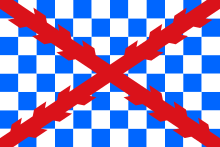 Unknown Tercio flag (appears near commander Ambrogio Spinola in the painting "The Surrender of Breda" of Diego Velázquez) (1621)
Unknown Tercio flag (appears near commander Ambrogio Spinola in the painting "The Surrender of Breda" of Diego Velázquez) (1621) Tercio de Alburquerque (1643)
Tercio de Alburquerque (1643)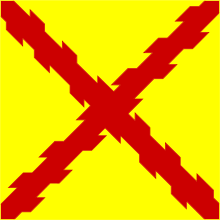 Tercio Morados Viejos (1670)
Tercio Morados Viejos (1670)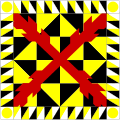 Tercio Amarillos Viejos (1680)
Tercio Amarillos Viejos (1680)
The Portuguese terços

Portugal adopted the Spanish model of tercio in the 16th century, calling it terço. In 1578, under the reorganization of the Portuguese Army conducted by King Sebastian, four terços were established: the Terço of Lisbon, the Terço of Estremadura, the Terço of Alentejo, and the Terço of Algarve. Each had about 2,000 men, formed into eight companies.
The infantry of the army organized for the expedition to Morocco in 1578 was made up of these four terços together with the Terço of the Adventurers (totally made up of young nobles), three mercenary terços (the German, the Italian, and the Castilian), and a unit of elite sharpshooters of the Portuguese garrison of Tangier. This was the Portuguese force which fought the Battle of Alcácer Quibir.
While united with the Spanish Crown, from 1580 to 1640, Portugal kept the organization of terços, although the Army had declined. Several Spanish tercios were sent to Portugal; the principal of them, the Spanish infantry Tercio of the City of Lisbon, occupied the main fortresses of the Portuguese capital. The Terço of the Navy of the Crown of Portugal, the ancestor of the modern Portuguese Marines, was created in this period.
After the restoration of Portuguese sovereignty in 1640, the Army was reorganized by King John IV of Portugal. The terços remained the basic units of the Portuguese infantry. Two types of terços were organized: the paid terços (first line permanent units) and the auxiliary terços (second line militia units). Portugal won the Restoration War with these terços.
At the end of the 17th century, the terços were already organized as modern regiments. However, the first line terços were only transformed into regiments in 1707, during the War of the Spanish Succession – after the Spanish tercios were transformed into regiments in 1704. The second line terços were only transformed into militia regiments in 1796. Some of the old terços are direct ancestors of modern regiments of the Portuguese Army.
Obsolescence

The first challenge to the dominance of the tercios came at the Battle of Nieuwpoort (1600). The victor of Nieuwpoort, the Dutch stadtholder Maurice, Prince of Orange, believed he could improve on the tercio by combining its methods with the organisation of the Roman legion. These shallower linear formations brought a greater proportion of available guns to bear on the enemy simultaneously. The result was that the tercios at Nieuwpoort were badly damaged by the weight of Dutch firepower. Yet the Spanish army very nearly succeeded in spite of internal dissensions that had compromised its regular command. The Eighty Years' War (1568–1648) in the Low Countries continued to be characterized by sieges of cities and forts, while field battles were of secondary importance. Maurice's reforms did not lead to a revolution in warfare, but he had created an army that could meet the tercios on an even basis and that pointed the way to future developments. During the Thirty Years War (1618–1648) tercio formations began to be tested in more linear formations by the brilliant Swedish soldier-king Gustavus Adolphus. Eventually, however, the tried-and-true Spanish tactics defeated the supposedly invincible Swedish army at the Battle of Nördlingen (1634).[10]
Throughout its history, the tercio's form and composition was never static as it evolved to meet new challenges. Tercio formations employed by well-trained troops with good cavalry support continued to win major battles such as Wimpfen (1622), Fleurus (1622), Breda (1624), Nördlingen (1634), Thionville (1639), Honnecourt (1641) and Valenciennes (1656). It was not until Rocroi (1643) that the Spanish tercio's reputation in major battles was shattered. Even then, the Rocroi defeat was precipitated by the collapse of the supporting cavalry rather than the failure of the tercios themselves, which had come close to besting the opposing infantry. Tercios continued to win important battles for a time after Rocroi and even after the Thirty Years War, but were already greatly modified from their older forms. By then, improvements in firearms and field artillery had given the new linear style a decided advantage. In response, the later 17th century "tercios" adopted so much of the linear style's organisation and tactics as to have little resemblance to the classic tercios of the previous century, with the men now armed with the musket. In 1704, the Spanish regular tercios were transformed into regiments, those of the reserves and the militia would later be transformed into similar formations.
Famous battles
Victories
- Cerignola (1503)
- Bicocca (1522)
- Pavia (1525)
- Muhlberg (1547)
- St. Quentin (1557)
- Lepanto (1571)
- Empel (1585)
- Paris (1590)
- White Mountain (1620)
- Fleurus (1622)
- Breda (1625)
- Nordlingen (1634)
- Kallo (1638)
- Honnecourt (1642)
- Valenciennes (1656)
Defeats
- Castelnuovo (1539)
- Alcácer Quibir (1578)
- Nieuwpoort (1600)
- Kinsale (1601)
- Rocroi (1643)
See also
- Spanish Empire
- Musketeer
- Military History
- Spanish Navy Marines units are called tercios
- The units of the modern Spanish Legion are also called tercios.
- Captain Alatriste
Notes
- Guthrie 2003, p. 180.
- This emphasis on the infantry was the result of Spain's shortage of cavalry and dependence on mules in daily life. Davies, T. R. 1961" Davies, T. R. (1961).
- Davis, Trevor. The Golden Century of Spain, 1501–1621 London: Macmillan and Co, 1961. Page 24.
- Lynch, John. The Hispanic World in Crisis and Change, 1578–1700 Cambridge: Blackwell, 1992. Page 117.
- Davies, T. R. 1961
- Lynch, John. Spain Under the Habsburgs, Volume One: Empire and Absolutism, 1516 to 1598. Oxford: Blackwell, 1964. Page 109.
- Lynch, Spain Under the Habsburgs page 200.
- Israel, The Dutch Republic, p. 185.
- Lynch, Spain Under the Habsburgs page 284.
- Laínez, Fernando Martínez (2011). Vientos de Gloria : grandes victorias de la historia de España. Madrid: Espasa. ISBN 9788467035605.
References
- Christon I. Archer, John R. Ferris, Holger H. Herwig, Timothy H. E. Travers – For a history of Spanish arms in the 16th and 17th centuries.
- Davies, T. R. (1961). The Golden Century of Spain 1501-1621. London: Macmillan & Co. – Brief description of the birth of the Spanish tercio.
- López, Ignacio J.N. The Spanish Tercios 1536–1704. Osprey Publishing - The history of the tercio from its antecedents to its decline and ultimate realignment into a regimental system in 1704.
- Spanish Tercio Tactics
- Renaissance Armies: The Spanish (myArmoury.com article)
- Spanish web site— Honors Alonso Pita da Veiga the most heroic Spaniard at the Battle of Pavia (Italy) 1525.
- Non-Official Web siteof the Modern "Spanish Marines" (in existence since 1537 few years after Battle of Pavia (Italy) 1525 and well before the Battle of Lepanto (Greece) 1571).
- The Spanish Army of the Thirty Years’ War
- List of Tercios